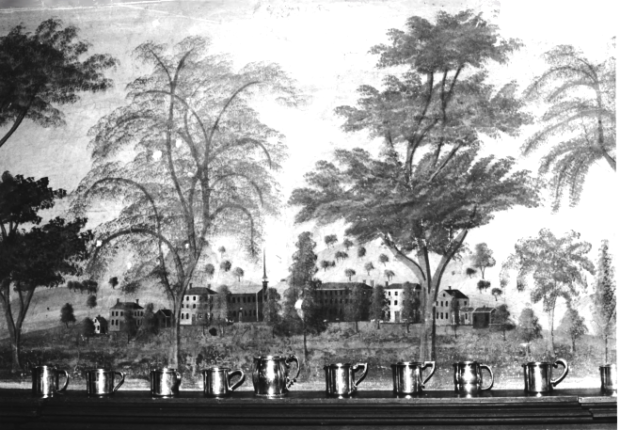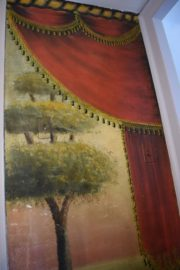Rufus Porter (1792-1884) was a muralist who produced his work in many Maine houses. The “Porter School” is named for him, a West Boxford, Massachusetts native and son of a prosperous farmer. Unlike his father, however, Porter would lead a life that carried him throughout New England, the mid-Atlantic states, and overseas, and expose his numerous talents as an artist, inventor and author.
The Rufus Porter Museum in Bridgton, notes: “He painted what he knew — landscapes depicting the farms around Bridgton, Maine, his childhood home, and seaport scenes of Portland, Maine, where he lived and studied as a young man. Porter patented inventions that were useful in the home, on the farm, and in the factory. The design for his revolving rifle cylinder, sold to Samuel Colt, helped to revolutionize the munitions industry. He designed and promoted airships that could fly people across the continent, although they were never built in his lifetime. He founded Scientific American magazine in 1845, to encourage innovation in American arts and sciences.”
Working as an itinerant portrait painter from 1815-1824, Porter then published an instructional book called Curious Arts in 1825 and devoted the next two decades to landscape murals. About 1823 Porter is believed to have been joined in his traveling portrait studio by his nephew Jonathan D. Poor (1807-1845). Among the Porter School muralists, Poor was the most prolific, especially in the years 1830-40. A large number of Maine murals are attributed to Poor, but they are virtually undistinguishable from Porter’s work, a fact that underscores Poor’s strict attention to his mentor’s guidelines.
Porter mural in Deacon Hutchins House in Rumford (B&W photo 1979)
Although Porter and Poor were undoubtedly responsible for many of the wall murals in Maine, it is also certain that other local artists were capable of producing similar treatments. One of these artists, Orison Wood (whom tradition states painted the murals in the Cushman Tavern in Lisbon has been suggested as the creator of the murals in the Hall house. However, neither a close comparison of stylistic elements or documentary sources confirm this attribution. What does distinguish these murals from others identified to date are the range of figures employed, particularly the horses, cat, mouse, and marine animals. The variation from the standard motifs of leaf-bearing trees, birds, and buildings set in a rolling landscape provides a clear indication as to the variety which this manner of early nineteenth century interior finish could assume.
[Edited and condensed from nomination of the Enoch Hall House in Buckfield to the National Register of Historic Places prepared by the Maine Historic Preservation Commission.]
Other places in which Porter murals have been reported in Bethel, Bridgton, Fryeburg, and Rumford.
Murals by others have been reported in: Biddeford, Lewiston (Kora Temple), Monmouth, Parsonsfield, Solon, Strong, Swanville, and Westbrook.
 This image of a 19th century mural is from a 2018 photo from the interior of the historic Nathan Harris House in Westbrook.
This image of a 19th century mural is from a 2018 photo from the interior of the historic Nathan Harris House in Westbrook.
Additional resources
Rufus Porter Museum. https://www.rufusportermuseum.org/aboutrufusporter (accessed January 23, 2020)



